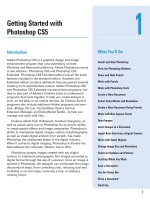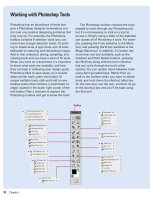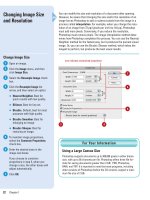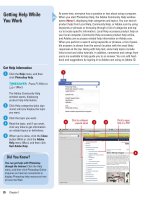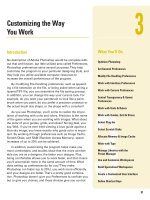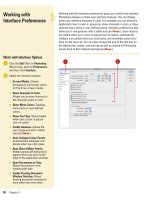Photoshop cs5 by steve Johnson part 61 doc
Bạn đang xem bản rút gọn của tài liệu. Xem và tải ngay bản đầy đủ của tài liệu tại đây (396.63 KB, 5 trang )
ptg
Controlling Image Output
Introduction
Once you create your Adobe Photoshop masterpiece, you
will have to decide the output for the image file. This is not
an easy decision. For example, an image created with a reso-
lution of 72 ppi might be fine if output to the Web, but would
not be of sufficient quality for output to a high-quality laser
printer. In addition, images saved in the RGB color space
would not work if the image were to be printed on a 4-color
press, which uses the CMYK color space.
Raster images (such as Photoshop files) do not handle
change very well, so it's important to design with a goal in
mind. Designers call this process a workflow. When you start
a Photoshop project you should have a good idea of where
the project is headed—to a press or inkjet printer, a copy
machine, or a monitor. Knowing this information helps you
design with the end in mind. That's not to say you can't make
changes to a Photoshop document; however, when it comes
to color space and resolution, the less change, the better the
output quality.
When preparing images for the Web, it's important to
understand that file size and format are important considera-
tions. People aren't very patient when it comes to download-
ing web pages. Creating good-looking, yet fast-loading
images keeps visitors on your web site, looking for more.
Photoshop gives you the ability to perform image compres-
sion using formats such as the JPEG (Joint Photographic
Experts Group), and GIF (Graphics Interchange Format) for-
mats. Those formats will make your images as small as pos-
sible, while still retaining great quality. In image preparation
it's all about control, and Photoshop gives you the tools to
make the job easy.
16
16
What You’ll Do
Set Document Print Options
Set Print Output Options
Print a Document
Change Printer Settings
Print One Copy
Understand File Formats
Save a Document with a Different
File Format
Insert File Information into a Document
Understand File Compression
Prepare Clip Art for the Web
Prepare a Photograph for the Web
Prepare an Image for the Press
Prepare an Image for an Inkjet or
Laser Printer
Understand Monitor, Image, and Device
Resolution
381
From the Library of Wow! eBook
ptg
382 Chapter 16
When you select the Print command, Photoshop displays a preview Print
dialog box , which gives you the opportunity to view the image (on
screen), and decide whether to print. The white area in the image pre-
view is the printable area, while the shaded border at the edge shows
the paper margins. You can adjust the position and scale of the image
and see the results. The size of the image is determined by the document
size settings in the Image Size dialog box. When you scale an image in
the Print dialog box, the changes only affect the printed image, not the
actual image. When you select a printer, Photoshop automatically
selects a printer profile for the best results (New!). If you want to use
the same print settings the next time you print, Photoshop can remember
your settings. In addition, when you save the image, your print settings
are saved along with it (New!), which allows for one-button printing.
Setting Document
Print Options
Set Document Print Options
Open a document.
Click the File menu, and then click
Print.
Click the Printer list arrow, and
then select a printer.
Choose from three output options:
◆ Match Print Colors. Select to
show the soft-proofed printed
colors in the Preview, and the
select any of the following:
◆ Gamut Warning. Highlights
out of gamut colors.
◆ Show Paper White. Sets
image whites to the color of
the paper being used to
compensate for off-white or
beige paper stock.
To chang e the ima ge or ientat io n,
click the Portrait or Landscape
button.
To have 16-b it pe r co lo r ch an nel
data sent to the printer (Mac only),
select the Send 16-bit Data check
box.
Select from the various Position
options:
◆ Center Image. Select to instruct
the output device to center the
image on the paper.
7
6
5
4
3
2
1
4 7
56
3
From the Library of Wow! eBook
ptg
Chapter 16 Controlling Image Output 383
◆ Top. Instructs the output device
to print the image from the top
of the page.
◆ Left. Instructs the output device
to print the image from the left
of the page.
Select from the various Scaled
Print Size options:
◆ Scale to Fit Media. Select to
scale the document to the
selected paper size.
◆ Scale. Enter a percentage
value.
◆ Height. Enter an image height.
◆ Width. Enter an image width.
Select from the various options:
◆ Bounding Box. Select to add a
bounding box around the image.
◆ Units. Specifies the units of
measure for size settings.
Click Print Settings to choose
setup options.
Click Print to open the Print dialog
box.
◆ To print one cop y wi th out
displaying the Print dialog box,
hold down Alt (Win) or Option
(Mac), and then click Print One.
Click Done to return to your
document without printing.
12
11
10
9
8
Preview of active image
11128
10
Displaying vs. Printing an Image
Although the image is displayed on a monitor, you still get to see an
accurate representation of how the graphic and all its associated lay-
ers and effects will appear. Remember, a monitor uses additive color
(RGB), and most output devices, such as printing presses, use subtrac-
tive color (CMYK). However, if you have a good, color-calibrated moni-
tor, you should have a good idea of how the image will look.
For Your Information
Did You Know?
You can manually scale and position
an image.
Select the Show Bounding
Box check box, and then clear the
Scale To Fit Media and Center Image
check boxes. Then simply drag the
image in the View window to reposi-
tion, and then click and drag a corner
to resize.
9
From the Library of Wow! eBook
ptg
384 Chapter 16
Setting Print Output
Options
Set Print Output Options
Open a document.
Click the File menu, and then click
Print.
Click the list arrow at the top right
of the Print dialog box, and then
click Output.
Select from the various Printing
Marks options:
◆ Calibration Bars. Prints a
gradient tint bar to compare
color ranges.
◆ Registration Marks. Prints
marks to align color
separations.
◆ Corner Crop Marks. Prints
marks where the page is to be
trimmed.
◆ Center Crop Marks. Prints
marks to identify the center of
the page.
◆ Description. Prints text
provided in the File Info
dialog box.
◆ Labels. Prints the file name at
the top of the page.
◆ Emulsion Down. Prints images
to film. Use to make type
readable when printing to
photographic paper facing
away from you.
4
3
2
1
On the right side of the preview Print dialog box, Photoshop not only
gives you access to its powerful color management tools, it also lets
you create calibration bars, add file name labels, and even place a cus-
tom border around the image. Click the Color Management list arrow,
and then click Output. Photoshop displays a listing of all the options
available, including the ability to print vector data or change the docu-
ment's encoding. For example, if you want to print a vector image that
includes shapes and type with optimal results, you can use the Include
Vector Data option to send the image to a PostScript printer. It's just
one more way that Photoshop gives you control over document output.
3
4
From the Library of Wow! eBook
ptg
Chapter 16 Controlling Image Output 385
◆ Negative. Prints an inverted
image. Use if you want to print
separations directly to film.
Select from the various Functions
options:
◆ Interpolation. Resamples the
image to reduce the jagged
appearance of a low-resolution
image.
◆ Include Vector Data. Select to
print a vector image. If the
option is grayed, the image
doesn’t contain vector data.
◆ Background. Selects a
background color to be printed
outside the image area.
◆ Border. Prints a black border
around the image.
◆ Bleed. Prints crop marks inside
rather than outside the image.
Click Print to open the Print dialog
box.
Click Done to return to your
document without printing.
7
6
5
5
67
See Also
See “Setting Document Print Options”
on page 382 for information on using
the preview Print dialog box.
From the Library of Wow! eBook
